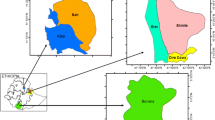Summary
A study into the economic effects of trypanosomiasis was carried out using three goat breeds at the south coast of Kenya. The economic losses were worked out by comparing the performance of the goat groups receiving Samorin on a monthly basis with that of goat groups not receiving any Samorin. The losses were based on quantities of weight lost through deaths and that not produced as a result of the disease. The groups of goats were exposed to natural trypanosomal challenge.
The losses in KSh per Tropical Livestock Unit within six months of the study were 198.07 for the East African goats, 501.95 for the Galla × East African goats and 785.42 for the Toggenburg × East African goats. The cost benefit ratio by using Samorin at the dose rate of 0.5 mg/kg body weight was 1:7.3, 1:18.52 and 1:28.94 for the three goat breeds respectively.
Résumé
Une étude sur les conséquences économiques de la Trypanosomose a été effectuée sur trois races de chèvres de la Côte sud du Kenya. Les pertes économiques ont été établies en comparant la performance des groupes de chèvres ayant reçu du Samorin chaque mois avec celle des groupes non traiés. Elles étaient basées sur les quantités de poids perdues avec la mort des animaux et de celles dues à la maladie. Les groupes de chèvres étaient exposés à l'infection trypanosomienne naturelle.
Les pertes en shilling kenyan par UBT au bout de six mois étaient de 198,07 pour les chèvres de l'est-africain, 501,95 pour les Galla × Est africaines et 785,42 pour les Toggenburg × Est africaines. Le rapport coût-bénéfice en utilisant le Samorin à la dose de 0,5 mg/kg de poids vif était respectivement de 1:7,3; 1:18,52 et 1:28,94 pour les trois races.
Resumen
Se realizó un estudio económico de los efectos de la tripanosomiasis, en tres razas de cabras, en la Costa Sur de Kénia. Las pérdidas económicas se calcularon, mediante la comparación entre la productividad de grupos de cabras las cuales recibieron Samorin mensualmente, y grupos que no recibieron la droga. Para evaluar las pérdidas, se tomó en cuenta el peso perdido por muertes debidas a tripanosomiasis, y las reducciones de peso no producidas por la enfermedad. Todos los grupos fueron expuestos a la infección natural.
Las pérdidas en (Ksh) por Unidad de Ganado Tropical, dentro de los seis meses del estudio fueron: 198.07 para las cabras Africanas Orientales, 501.95 para el cruce Galla × Africanas Orientales, y 785.42 para las Toggenburg × Africanas Orientales. El rango costo beneficio utilizando Samorin en dosis de 0.5 mg/kg de peso fué: 1:7.3; 1:18.52 y 1:28.94 para las tres razas respectivamente.
Similar content being viewed by others
References
FAO/WHO/OIE (1962).Animal Health Yearbook,7, 284–291.
Finelle, P. (1974).World Animal Review,10, 15–18.
Griffin, L. & Allonby, E. W. (1979).Tropical Animal Health and Production,11, 127–132.
Isoun, T. T. & Anosa, V. O. (1974).Nigerian Journal of Animal Production,2, 143–150.
Kaaya, G. P. & Oduor·Okello, D. (1980).Bulletin of Animal Health and Production in Africa,28, 1–5.
Paikne, D. L. & Dhake, P. R. (1972).Indian Veterinary Journal,49, 1091–1092.
Author information
Authors and Affiliations
Rights and permissions
About this article
Cite this article
Kanyari, P.W.N., Allonby, E.W., Wilson, A.J. et al. Some economic effects of trypanosomiasis in goats. Trop Anim Health Prod 15, 153–160 (1983). https://doi.org/10.1007/BF02239926
Accepted:
Issue Date:
DOI: https://doi.org/10.1007/BF02239926




